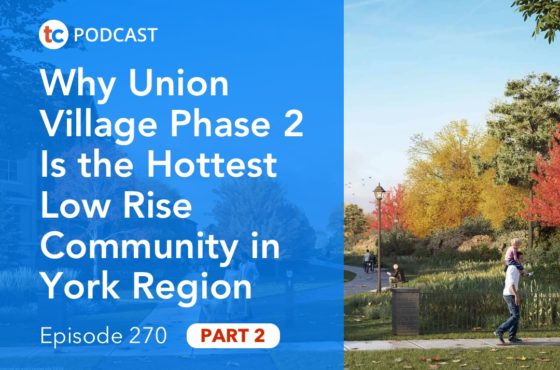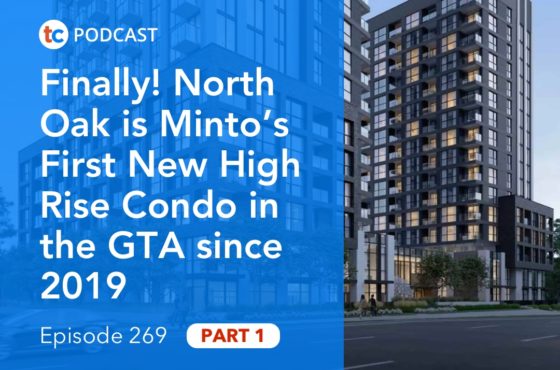The Analytical Mistake That So Many First Time Investors Make and What You Should Do Instead

Buying your first investment condo is a big step. It takes courage and commitment (and cash!) to make it happen. There is one common analytical mistake I see so many first time investors make, one that could cause you to keep missing out on great opportunities. Find out what it is and what you should do instead.
Related Links
Click Here for Episode Transcript
| Andrew la Fleur: | There’s one common analytical mistake that I see so many first-time investors making. This one mistake keeps people in the sidelines, and keeps them from getting into the market and making money. I’ve seen it over and over again. On today’s episode, we talk about what that mistake is, and what you should do instead.
|
| Speaker 2: | Welcome to the True Condos podcast with Andrew la Fleur, the place to get the truth on the Toronto condo market, and condo investing in Toronto.
|
| Andrew la Fleur: | Welcome back to the show. As I said in the intro, today we’re going to be talking about a common analytical mistake that I see so many first-time condo investors making, or might be more accurate to say, “would-be condo investors making,” because it’s something that prevents many people from making that first step and buying that first condo for investment.
|
| What is it? You’re probably wondering this, so I’ll break the suspense. What is this mistake that is so common? Well, the mistake is the mistake of not buying a condo because the price per square foot is too high, or conversely, buying a certain condo because the price per square foot is perceived to be low. Well, the truth is that per square foot, or PSF as I might also refer to it in this episode, PSF, is determined by a number of different factors and a number of different reasons why a per square foot price might be high or per square foot price might be low, in any given building, in any given unit, and it’s not something that should be a primary factor in determining whether an investment is a good one or a bad one.
|
|
| Just to make sure everybody’s on the same page, per square foot, again, if you’re new it, per square foot is basically when you’re taking the price of a unit, let’s say the unit is $1 million, and the size of the unit, let’s say, is 1,000 square feet. 1,000 square feet, $1 million, that is $1,000 per square foot. The average price per square foot right now in Toronto, at the end of 2016, for centrally located, prime, downtown condos, is somewhere around $700 to $800 per square foot. For the prime stuff downtown you can still get very good product in the sort of $600 to $700 per square foot range. Getting very, very harder and harder to get anything decent under $600 a square foot. That’s where we are, sort of, today, and anything above $800 a square foot is generally getting into the super-prime or luxury type of product. Of course, the high end of the market is around … Well, it’s anywhere from $1,000 to $1,500 a square foot for top, top end, Yorkville sort of products. That’s just a snapshot of where things are today.
|
|
| That is the mistake that I see so many people doing, and this triggered this episode, is I had a client, or, again, a would-be client, perhaps one day will be a client, but not yet, who had signed a contract for a particular unit at a building that I have endorsed as a top-notch investment opportunity. A building that I actually personally have invested in myself. Great, great building. Great unit that they had. They decided not to go ahead. They canceled their contract to purchase during their 10-day cooling off period. The reason given was that the price per square foot, they felt, was too high for the unit.
|
|
| Now, again, this is not to knock this particular investor, or the reasons why they did that. They might have a number of other reasons which they didn’t mention, but this is a common thing that I do hear many first-time investors saying. “No, Andrew, I don’t like that because the price per square foot is too high, so I’m going to pass.” Time and time and time again, I’ve seen people miss out on opportunity, miss out on tremendous returns and price growth because they have this false belief that the price per square foot is too high, and therefore it can not get any higher, and therefore it’s a bad investment. This kind of thinking. That’s the end result of this false mentality.
|
|
| I’ll give you one example from my own investment experience. One of the first units that I purchased back in … I think it was 2010, I believe. 2010, I purchased a studio at One Park West. One Park West was a building in Regent Park, as part of the Regent Park revitalization there. That was the second building that they had launched, after One Coal. One Coal was 2009. Yes, so this was 2010. One Park West. I purchased a 301 square foot studio, believe it or not. You’d be shocked to hear the price now, of course, but back then it was a different story.
|
|
| The price was $165,000. I purchased a condo in downtown Toronto for $165,000, and if you do the math, the per square foot price was $551, which, again, today, $551 per square foot for anything sounds like a ridiculous bargain, but at the time, in 2010, this unit and my decision to purchase this unit as an investment was, I guess you could say, pretty widely criticized. Not widely, but there were certain people in the industry, in the market, who looked at the price of that unit, on a per square foot basis, which was $551 at the time, and they said, “That is too high. The price per square foot for Regent Park should be more like $400 a square foot.” $551 per square foot, at the time, when everything else was supposedly perceived to be $400 a square foot, “That is too high. It’s going to be a bad investment. You shouldn’t buy that unit. Forget about it.” Well, I thought otherwise. I thought it was great value. I purchased the unit, obviously. The rest is history. We know that the days of purchasing studios for $165,000 are long, long gone. The unit appreciated tremendously in value. Was a great rental property for me for a number of years, and I recently sold that unit as I needed some funds for another property that I was purchasing.
|
|
| Again, all that to say that the price per square foot was really … It seemed, it was perceived to be high at the time, but it wasn’t the case at all. The price per square foot quickly rose much, much higher. Quickly went from $551 per square foot to around $700 a square foot within about two years, I’d say. It was jumping up that high. It appreciated at a much faster rate than really anything else in the building, anything else in the area. It was a fantastic investment, and I’ve had many, many other clients that have purchased similar units over the years, and have also done similarly well with their investments, too. That’s just one example of, again, a missed opportunity, or people putting their criticisms on something that just turned out to be completely wrong.
|
|
| What should you know about PSF, per square foot, when you are investing? Well, what you should know, really, is simply that there are many, again, as I stated before, there are many, many factors that affect the price per square foot. It is not a black and white sort of equation. It’s not something that you can just simply look at a number and know whether a condo is a good or a bad investment. Just say, “Well, here’s an investment. Would you like to buy it?” “Well, what’s the per square foot?” “It’s this. Yes or no?” It doesn’t work like that, but unfortunately many first-time investors seem to think it does, and many will base their decisions on the per square foot price more than anything else, or sometimes exclusively basing it on the PSF. This is definitely a mistake that, if you’re making that mistake, you’re missing out on great opportunities potentially, or you’re buying something that is really not a good opportunity, just because you think it’s a low price per square foot. There might be reasons for that.
|
|
| What should you do instead? If you’re a first-time investor, you’re thinking about investing in a condo, what would my advice be to you, as you are analyzing different opportunities and considering which unit or what project you should buy into? Well, I want to give you four things here that you should do instead of just basing your decision on price per square foot. Number one is, look at the end price versus the per square foot price. What I mean by the end price is, look at the actual price of the unit. In the case of my studio, I looked at that back in 2010 at $165,000, and I said, “Where in downtown Toronto can you purchase a studio, or any condo, or any property whatsoever for $165,000?” Of course, the answer was, “Nowhere.” Even back in those days, $165,000 was just an unheard of price for a condo. I said, “Well, obviously if this is far cheaper than any other piece of real estate in the downtown core, then the chances of this one appreciating is very, very good, and the size of it, being only 301 square feet, which, at the time, it was the smallest condo in Toronto, that is not as relevant. Look at the end price, instead of looking at the price per square foot.
|
|
| Another thing you want to look at with end prices is look at the end price of the unit versus the average resale end prices of the same type of units in the resale market. If you think about buying a one bedroom in a pre-construction building, and you can get a one bedroom for, say, $300,000, and if you look at, “What are the average resale prices for all one bedrooms in the resale market?” In recent months that you’re looking at buying, in the same area that you’re looking at buying. The average price is, say, $350, and you’re able to purchase a one bedroom for $300,000, again, that is a very good sign. That’s a sign that the chances of appreciation on that property are very, very good, regardless of the size of the unit. That’s the first thing. Number one.
|
|
| Number two is, look at the functionality of the floor plan, rather than the size of the floor plan. Again, people get hung up on per square foot, and the size of the unit. Again, going back to the example of my studio, which I always come back to, again and again, 301 square foot studio, at the time, smallest condo in Toronto. Many people just look at the number and they say, “That’s too small. You shouldn’t buy that. No one will live there. Who the heck wants to rent or buy a 301 square foot condo?” Whereas I looked at it, and I said, “Can it fit a bed? Yup. Can it fit a table? Yup. Can it fit a dresser? Yup. Does it have a bathroom? Yup. Does it have a kitchen? Yup. Okay, it’s a studio.”
|
|
| Often, we get, as investors in the pre-construction market, we sort of are detached with reality. The reality of the resale market, and what people are actually … The behaviors of the consumer at the actual resale market. The real buyers, and the real renters who are going and living in these units. We’re just buying floor plans. We’re buying paper. We’re buying contracts that will one day turn into a piece of real estate. We have this sense of detachment from what’s actually happening on the streets, so-called, in quotations. What do real people do? All this to say, “What do real people do?” Well, real people buy or they rent based on functionality. This is a key, key point that many people do not understand or do not consider. People buy function. They do not buy square feet. I’ll say that again. People buy function. They do not buy square feet. They don’t really care whether a unit, like an example of a studio, whether it’s a 400 square foot studio or a 300 square foot studio. It’s still a single room with a kitchen and a bathroom. It doesn’t really make that much of a difference if the room is a larger room or a smaller room. It’s still the same room, and that is how units tend to be bought and tend to be rented. However, that’s usually not how they’re sold.
|
|
| You do have to pay a premium when you’re buying it for pre-construction for the larger space. You’re paying a lot more for the larger space, but when you go to rent it, or when you go to resell it, you’re not necessarily getting that money back, which, again, goes back to one of my core principles and core teachings that I’ve always taught my investors, is to buy the … The great rule of thumb is to buy the smallest unit of a given type, and that’s going to give you the best investment. The smallest unit of a given type. I’ll include a link to that in the show notes for this episode. If you haven’t heard me talk about that principle, you can hear the podcast or read the articles about that. That’s the second point. Look at the functionality of the floor plan, and consider the functionality. How it operates, how people can live in the unit, more so than the actual size or the price per square foot of the unit. That’s number two.
|
|
| Number three, third point of what you should do instead. Number three is, sometimes it makes sense to buy the lowest price per square foot in a building, and sometimes it actually makes sense to buy the highest per square foot in the building. That’s really the key, is there’s different reasons. Again, going back to the things that affect price per square foot, there’s many different reasons or factors that affect the price per square foot. In some cases, the best investment in the building is the unit with the highest price per square foot. Maybe it’s a tiny studio. Maybe it’s a small two bedroom that’s beautifully laid out and perfectly efficient. Then, it ends up having a high price per square foot, but the future resale and future rental potential of that unit is better than all the other units.
|
|
| Other times, it might be the lowest price per square foot. Maybe there’s a low floor unit, podium unit, courtyard unit, faces another building. Maybe it’s beside a garbage chute, something like that, beside the amenities. There might be some reason why there’s one particular unit that has the lowest price per square foot in the building, and it might be the best idea to buy that unit for investment. It really depends. There’s many different factors and reasons that go into it, so each unit has to be evaluated on its own merits, and on its own, not just a broad brush against everything. That’s the third point.
|
|
| The fourth point of what you should do instead is, when you’re looking at price per square foot, is price per square foot is useful when comparing a building versus a building. It’s not as useful, and it tends to be abused and misused when you’re comparing on a micro level of a particular unit versus unit, because there’s so many factors that go into it. When you’re comparing building versus building, that’s where I find it is more useful, is when you just look at the average price per square foot of an entire building, versus a competitive property next door, or a resale building in the area. That’s where it can be useful, when you’re looking at it on a macro level. A group of units, with the prices that they’re selling at, versus a group of units in another building that they’re selling at, and to see where there may be opportunities.
|
|
| Again, buying below market value, something I’m always talking about. If you have an opportunity to purchase in a new building, pre-construction, where the average per square foot price is, say, $650 a square foot, and you look at the average per square foot price selling in the nearby, the right next door, brand newly built and finished resale building, if they’re selling at $700 a square foot and you can buy a next door pre-construction at $650 per square foot as the building average price, then generally that’s probably going to be a good building to get into. Now, you’re going to have to pick and choose which unit you’re going to buy based on some of the things we talked about, but that’s a good starting point to say, “That is probably a good investment to get into, because I look at the whole building versus the other whole building, and I see the trend. I see the direction, and that’s a good place to start.”
|
|
| That’s four tips for you there, of what you should do instead. In conclusion, conclusion of today’s episode, price per square foot is just one measure. You don’t want to get too hung up on it. Yes, it is something to consider. Yes, it is a factor to look at always, but it’s not the be all and end all, and if you’re basing your decision whether to buy or not to buy solely based on the price per square foot, you are doing it wrong. You’re making a mistake, and you’re probably leaving good opportunities on the table you’re missing out on, or, conversely, you might be buying something that is not good, you should not be buying, just because you perceive it to be cheap, when really there might be reasons for that.
|
|
| You should really only use price per square foot as a factor when you’re directly comparing apples to apples. If you could somehow have the same or very, very similar unit, same floor height, same exposure, same quality of finishes, location, amenities, et cetera. If you had everything basically the same, and you could compare one unit versus another in another building, then there it’s a useful exercise to do. Other than that, it tends to not be a very valid form of evaluating a particular investment. You want to do the other things instead that I mentioned. You want to look at the end price, focus more on the end prices rather than on the price per square foot. You want to focus on the functionality of the floor plan as opposed to the square footage, because remember, real buyers and real renters, they buy functionality, not square feet.
|
|
| Sometimes it makes sense to buy the lowest price per square foot in the building, and sometimes it makes sense to buy the highest price per square foot in the building. You need to consider that. The fourth point was, when using price per square foot, as a useful tool, look at the entire building average versus a competitive average for an entire building, and that is a good starting point to see if that’s a building to look at getting into.
|
|
| That was a little bit longer than I was anticipating for today’s episode, but I hope you enjoyed it. As always, I hope that you got some good information, advice, and expertise from me, for free as always, on today’s episode. If you liked it, share it with a friend or pass this along. I really appreciate that. You can always leave a review for me on iTunes for this podcast, if you’ve been listening and you like it. Thank you very much for all of the many kind words I’ve received from so many of you listening, and many people that I meet, every weekend and every week, tell me that they find this podcast useful, and I love to hear that, and I thank you for the feedback.
|
|
| Until next time, have a great week, and we’ll talk to you soon.
|
|
| Speaker 2: | Thanks for listening to the True Condos podcast. Remember, your positive reviews make a big difference to the show. To learn more about condo investing, become a True Condos subscriber by visiting TrueCondos.com.
|



